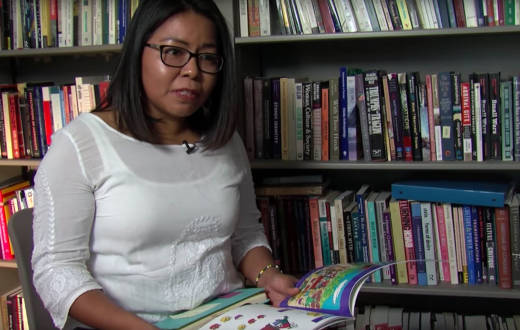“It’s supported by the administration this time. Hopefully it’s not going to go away,” Pérez said. “It’s going to be a natural part of student life here on campus.”
For Vicki Calvario, who grew up speaking English at home in Logan Heights and Nahuatl during summers with her grandmother in Guerrero, Mexico, the importance of the course transcends campus politics.
She said indigenous cultures and languages have long been overshadowed by the mainstream, including in the predominantly Latino Logan Heights neighborhood.
“I was never thought of as being Mexican. It was always pointed out to me that I did not fit into that community because my skin color was very much darker than the rest of my Mexican peers,” Calvario said. “My Mexico and my Mexico reality was different than what they noted as Mexico.”
Calvario is now earning a master’s degree in anthropology and studying efforts to revive the Nahuatl language in Guerrero. She said learning a language offers important insight into the culture of those who speak it.
“It’s very motivating and encouraging to know that now more individuals are going to be becoming aware of the beauty and the splendor of this language that is not dead. It’s very much alive,” she said. “And hopefully this will be an entry into them learning about the other worlds that are in Mexico.”
Calvario offered an example of the kind of context language can provide — and of how Spanish colonialism has challenged preservation of Nahuatl. She read the following phrase from a book.
“Zazan tleino. Quatzocoltzin mictlan ommati.”
“In English this is saying, ‘Up and down the well I got used to hell,’” Calvario said. “So mictlan is referencing the underworld that is part of the Nahuatl world vision before colonialism and the influence of the Catholic religion. Mictlan was just a place where people went after one ceased to be in the physical world. It was not a hell, it was just a place of rest.”
Calvario will assist students in the course, which is being livestreamed from the University of Zacatecas. The class is open to any student and members of the public through Open University, but will be capped at 15 students. The university will add sections in subsequent semesters as it builds a full two-year program in the language.
The University of Utah, Stanford and UCLA also offer the course in this format.
“It’s an amazing language. It’s an amazing worldview. And I think once people get into it, they’re going to find that what they learn not only in terms of language, but understanding a new way to be in the world, is really exciting,” Pérez said.
There is no estimate for the number of Nahuatl speakers in the United States, but Pérez said there is a need for Nahuatl interpreters across social service sectors. She added many of Mexico’s classical texts are in Nahuatl.
As for the Aztec mascot, its long-term future is unclear.
In a nonbinding action, the University Senate voted to discontinue the mascot last month, just seven months after a divided Associated Students voted in favor of the mascot.
Both decisions are meant to advise the university’s president, and in the midst of a search for her replacement, interim President Sally Roush is unlikely to make the call.

